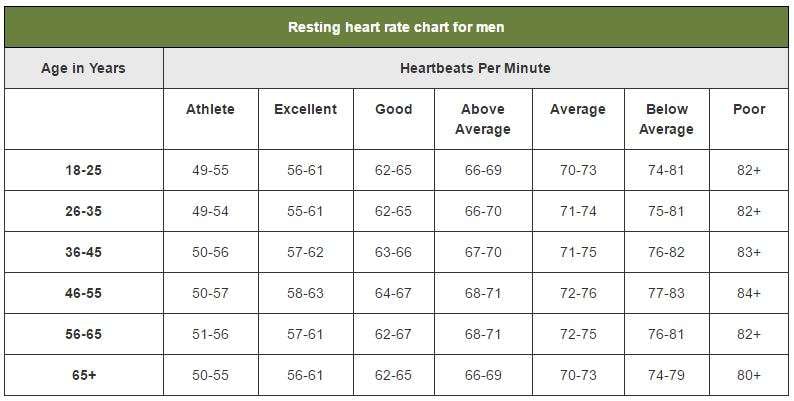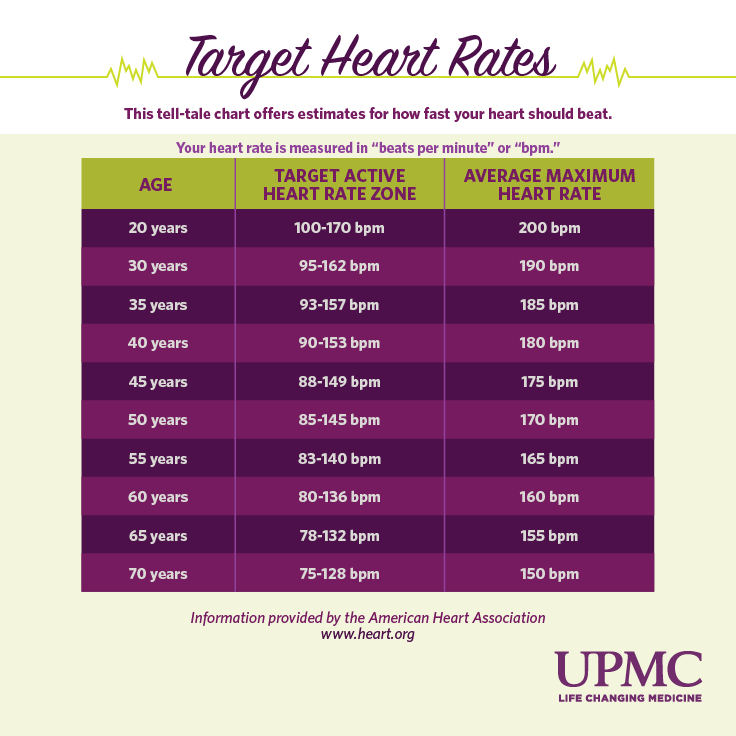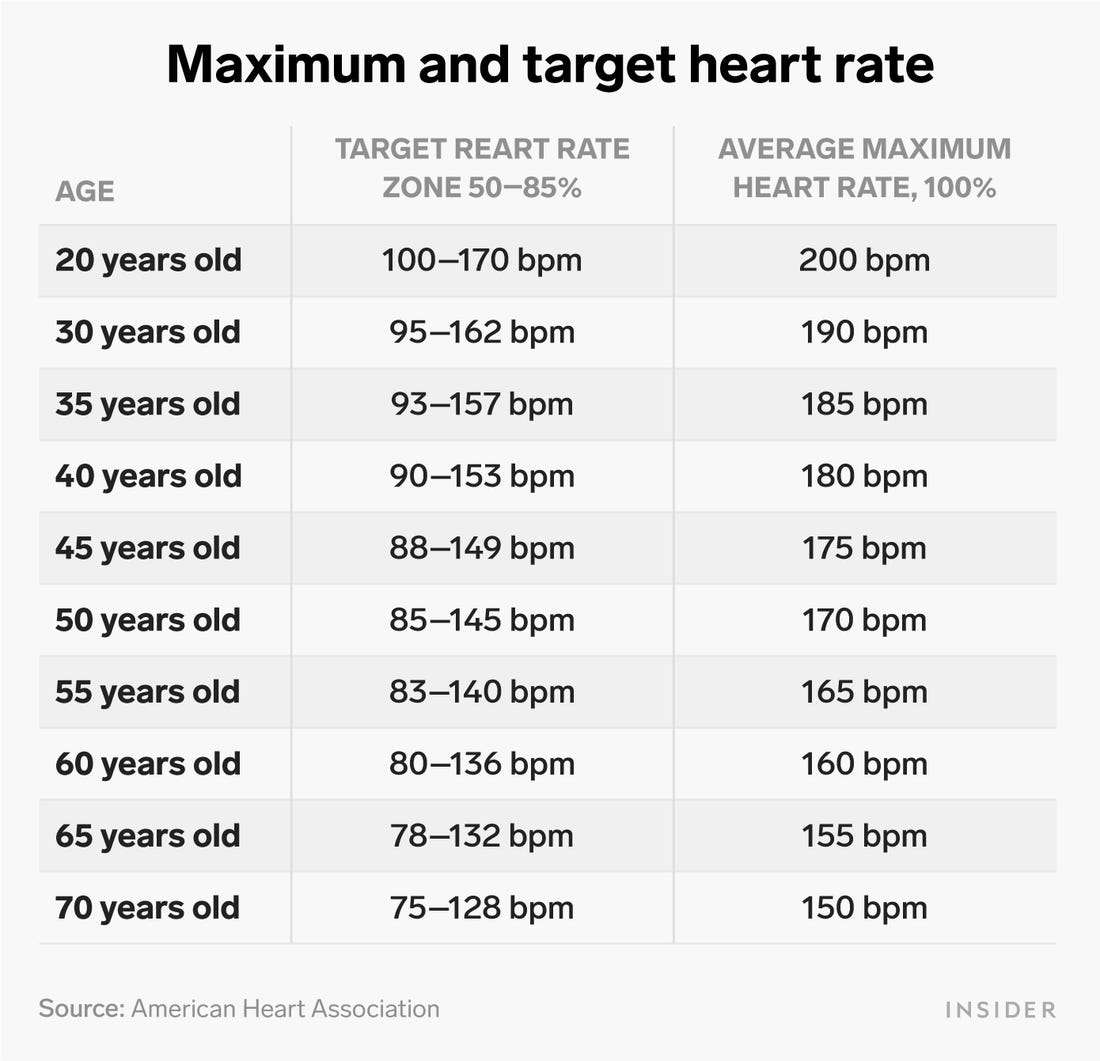Heart Rate Tips To Keep In Mind
- Start at your beginning. Before getting overly concerned about your heart rate, Martin says, its best to simply get moving. If you havent exercised much before, start where youre comfortable and gradually exert yourself more over time.
- Listen to your body. Your body provides other indicators of how hard its working that you need to consider along with heart rate. Pay attention to how hard youre breathing or sweating, and stop if you feel very uncomfortable, Martin says. Devices recording your heart rate have been known to malfunction, for exampleanother reason listening to your body is important.
- Remember that target heart rate is just a guide. Dont get overly fixated on numbers, Martin says. Ideally, they just push you to work a little harder.
What Is A Normal Resting Heart Rate
A normal resting heart rate for adults is between 60 beats per minute and 100 bpm. An abnormal pulse rate below 60 bpm or above 100 bpm could increase your risk of cardiovascular disease, stroke, or early death.
Normal Resting Heart Rate for Women
The normal resting heart rate for adult women is similar for men, between 60 bpm and 100 bpm. Age and activity level are more important factors for heart rate.
Studies show that having high resting heart rate increases your risk even after controlling for other factors such as physical fitness, blood pressure, and lipid levels.
Is a resting heart rate of 80 bad? A bpm of 80 is still within the normal range, but over 90 can be dangerous.
For example:
One study tested the resting heart rate of about 3,000 men over 16 years. The study found that, after accounting for other risk factors, men with a resting heart rate over 90 bpm were three times more likely to die than the men with the lowest RHR.
Further, an increase in heart rate over time is associated with an increased risk of death from heart disease and all-cause mortality.
Is A Low Resting Heart Rate Good Or Dangerous?
At the other extreme, one study found that having a low resting heart rate is a risk factor for atrial fibrillation in athletes.
Having a heart rate below 60 bpm doesnt mean that youre not healthy. For example, a low RHR could be the result of taking a drug such as a beta-blocker. Moreover, athletes generally have lower heart rates.
Factors That Affect Resting Heart Rate
When measuring your RHR, keep in mind that there are a number of things that can affect your reading, including:
- Age: RHR can decrease with age, according to some studies.
- Gender: On average, women’s RHR tends to be two to seven beats per minute higher than men’s.
- Air temperature: RHR can increase during hot weather, but usually not more than 10 bpm.
- Emotions: Strong feelings of stress, anxiety, or even happiness can raise your RHR.
- Body position: RHR can be 3 bpm higher when sitting versus lying down. Similarly, RHR tends to increase a bit upon standing.
- Medication: Prescription drugs like antidepressants and beta blockers can cause your RHR to be higher or lower than it would if you weren’t taking the medication.
Don’t Miss: Constipation And Heart Palpitations
What Is Considered A Normal Heart Rate
One of the simplest body functions to measure is the heart rate or pulse, which is the number of times the heart beats per minute. The normal heart rate, also called the resting rate, can be measured after the patient has rested for 10 minutes. Factors such as age, gender and fitness level come into play when determining a person’s normal pulse. Typically, however, an adult should have a resting heart rate of 60 to 100 beats per minute.
The normal heart rate for fetuses is higher than that. Fetal movement can raise the heart rate temporarily. When the mother experiences contractions, the fetus may show a drop in pulse. A range of 120 to 160 beats per minute is considered a normal rate while in utero. This can indicate that the fetus is growing well and is not in distress.
During the first year of life, the normal heart rate range expands to 100 to 160 beats per minute. A slightly lower heart rate of 60 to 140 is typical in children aged one through 10 years. Deviations from the normal rate for children can be caused by anemia, fever or breathing problems.
Oral Medications And Supplements

Oral medications and supplements are often used to correct chronic mineral abnormalities in your body. This is more common in if youve been diagnosed with ongoing kidney disease.
Depending on your electrolyte disorder, you may receive medications or supplements such as:
- calcium (gluconate, carbonate, citrate, or lactate
- magnesium oxide
- potassium chloride
- phosphate binders, which include sevelamer hydrochloride , lanthanum , and calcium-based treatments such as calcium carbonate
They can help replace depleted electrolytes on a short- or long-term basis, depending on the underlying cause of your disorder. Once the imbalance has been corrected, your doctor will treat the underlying cause.
Although some of the supplements can be purchased over the counter, most people with electrolyte disorders get a prescription for supplements from their doctor.
Read Also: Does Tylenol Increase Heart Rate
Normal Resting Heart Rate For Kids
Childrens heart rates are normally faster than those of adults. According to Cleveland Clinic, the normal resting heart rate for a child aged six to 15 is between 70 to 100 beats per minute.
Many factors can affect your resting heart rate, including your level of physical activity. In fact, highly trained athletes can have a resting heart rate of around 40 beats per minute!
Other factors that can affect resting heart rate include:
- Age. You may find that your resting heart rate decreases as you get older.
- Temperature. Your heart rate may increase slightly when youre exposed to hot temperatures.
- Medication side effects. For example, medications such as beta-blockers can lower your resting heart rate.
- Emotions. If youre anxious or excited, your heart rate may increase.
- Weight. People who are obese may have a higher resting heart rate. This is because the heart has to work harder to supply the body with blood.
- Body positioning. Heart rate can increase temporarily when you move from a sitting to a standing position
- Smoking. Smokers tend to have a higher resting heart rate. Quitting smoking can help bring it back down.
How To Check Heart Rate Pulse In Dogs Cats Miss
Healthy Resting Heart Rate By Age for Men and Women. The normal resting pulse range for adults is 60 to 100 beats per minute. This is usually their resting pulse rate. For adults, the normal pulse rate is considered to be around 60 beats per minute. Normal ranges vary by age, and women usually have slightly higher pulse rates compared to men.
Read Also: Does Benadryl Lower Heart Rate
How Do I Check My Resting Heart Rate
To check your heart rate:
- Sit down and rest for 5 minutes.
- Turn your wrist so your palm is facing up.
- Feel for a pulse at thumb side of your wrist.
- Once you feel it, count how many times you feel a beat in 30 seconds. Then double it.
If you cant find your pulse at your wrist, put 2 fingers on the side of your neck, next to the windpipe.
If you still cant find a pulse, ask someone else to feel it for you.
Correlation With Cardiovascular Mortality Risk
| This section needs more medical references for verification or relies too heavily on primary sources. Please review the contents of the section and add the appropriate references if you can. Unsourced or poorly sourced material may be challenged and removed.Find sources: “Heart rate” news ·newspapers ·books ·scholar ·JSTOR |
A number of investigations indicate that faster resting heart rate has emerged as a new risk factor for mortality in homeothermic mammals, particularly cardiovascular mortality in human beings. Faster heart rate may accompany increased production of inflammation molecules and increased production of reactive oxygen species in cardiovascular system, in addition to increased mechanical stress to the heart. There is a correlation between increased resting rate and cardiovascular risk. This is not seen to be “using an allotment of heart beats” but rather an increased risk to the system from the increased rate.
Given these data, heart rate should be considered in the assessment of cardiovascular risk, even in apparently healthy individuals. Heart rate has many advantages as a clinical parameter: It is inexpensive and quick to measure and is easily understandable. Although the accepted limits of heart rate are between 60 and 100 beats per minute, this was based for convenience on the scale of the squares on electrocardiogram paper a better definition of normal sinus heart rate may be between 50 and 90 beats per minute.
Recommended Reading: How Do You Say Heart Attack In Spanish
What’s A Normal Heart Rate
Most adults have a resting heart rate between 60 and 100bpm.
The fitter you are, the lower your resting heart rate is likely to be. For example, athletes may have a resting heart rate of 40 to 60bpm, or lower.
See a GP to get checked if you think your heart rate is continuously above 120bpm or below 40bpm, although it may simply be that this is normal for you.
Visit the British Heart Foundation for more information on checking your pulse.
Normal Healthy Resting Pulse Rates For 73 Year Olds
The average resting heart rate for a 73 year old is 72 beats per minute2. 73 year old males average heart rates of 70 bpm while females average slightly higher at 73 bpm2. The normal resting heart rate range for all adults and children 10 and over is between 60 and 100 beats per minute3. 90% of 73 year olds resting pulses fall within the range of 54 to 91 bpm. In general, an adult’s resting heart rate will be lower for those in better athletic condition. See also: Exercising heart rates for 73 year olds
Resting Heart Rate Chart 73 Year Olds
| Percentile |
|---|
Also Check: Can Flonase Cause Heart Palpitations
Understanding Your Target Heart Rate
Nearly all exercise is good. But to be sure youre getting the most fromyour workout yet staying at a level thats safe for you, you can monitorhow hard your heart is working.
Aiming for whats called a target heart rate can help you do this, says Johns Hopkins cardiologist Seth Martin, M.D., M.P.H. Think of it as the sweet spot between not exercising hard enough and overexerting.
How To Calculate Resting Heart Rate

To check your normal resting heart rate, you can use a heart rate monitor, or use this 10-second pulse count method:
- Take your pulse at either the base of your thumb on the palm side of your wrist, or the base of your neck on either side of your windpipe.
- Using two or three fingers, press lightly on your skin until you can feel your blood moving underneath.
- Count the beats for 10 seconds, then multiply that number by six.
You May Like: Which Of The Following Signs Is Commonly Observed In Patients With Right-sided Heart Failure
Ayurvedic Medicine For Heartbeat
What is a heart rate or pulse rate? Number of time heart . Heart rate is the speed of the heartbeat measured by the number of contractions of the heart per minute . The heart rate can vary according to the body’s physical needs. Tachycardia is considered a heart rate of greater than 100 beats per minute. A rapid or fast heartbeat is when your heart is beating faster than normal.
What Is An Average Resting Heart Rate By Age
When you are resting – whether sitting or lying down – you can check your resting heart rate. Provided that you have not smoked, consumed coffee, or exercised vigorously an hour before. Activities such as smoking, having coffee, loud noises, and vigorous physical activity make your heart beat faster for a while, and so you might not get your exact resting heart rate. And hence this may interfere with the correct heart rate.
Average resting heart rate by age:
Children : 70-100 beats per minute
Adults : 60-100 beats per minute
Recommended Reading: How To Find Thrz
What Is Considered Normal Pulse Rate
What Is Considered Normal Pulse Rate. This is usually their resting pulse rate. Normal ranges vary by age, and women usually have slightly higher pulse rates compared to men. The normal resting pulse range for adults is 60 to 100 beats per minute. For adults, the normal pulse rate is considered to be around 60 beats per minute. What is a good pulse rate for men?
What Is A Resting Heart Rate
The resting heart rate of the body is the number of contractions of the heart that occur in a single minute while the body is at complete rest. This number will vary depending upon the age, gender, and general health of a person. There will also be a large difference in the resting heart rate of athletes when compared to non-athletes
In general terms the resting heart rate of a person is a strong indicator of that persons basic level of fitness. The strength of the heart can be measured simply by taking the resting heart rate into account. A strong heart can pump more blood each contraction, meaning that a strong heart needs to beat less times per minute than a weak one in order for the body to have adequate blood flow. Thus, those who have a high resting heart rate do not have a sufficient level of fitness. Athletes will have the lowest resting heart rate of anyone, as they have had plenty of training to strengthen the heart in order to perform. This allows the heart of an athlete to pump a larger amount of blood per beat than that of an unconditioned person.
Your Resting Heart Rate is the number of times your heart beats while doing nothing. This number is determined by taking your one minute pulse rate when you wake in the morning before getting out of bed.
According to the National Institute of Health, the average resting heart rate:
Read Also: How Much Can Marijuana Increase A Person’s Heart Rate
What Is A Healthy Resting Heart Rate For An Adult
A normal resting heart rate for adults lies somewhere between 60 and 100 beats per minute , and varies based on age group and gender. Women’s heart rates are about 2-7 BPM faster than men’s on average.
Generally speaking, you want to keep your resting heart rate as low as possible. One large, long-term study compared men with heart rates above 90 and those below 80. The men with higher average heart rates were associated with triple the risk of death.
People with lower heart rates tend to be more active and get more exercise than others. A young, highly-trained athlete’s healthy resting heart rate may be as low as 40 BPM.
Zone 5 Maximum Effort
In this zone, youre exerting yourself at 90 to 100 percent of your maximum heart rate. Talking is out of the question, says Thieme, as your heart and lungs are now working at full capacity with a single purpose: to drive as much oxygen into your bloodstream and to your muscles as possible, as quickly as possible.
You May Like: Ibs Heart Palpitations
What Treatments Are Available For Patients With Bradycardia
If you have bradycardia but do not have any symptoms, or if the bradycardia doesnt happen often or last long, you may not need treatment. Sometimes bradycardia is a good thing and is the goal of treatment.
If you need treatment, it will be based on the cause of the condition. If you have an electrical problem in your heart, you will need a pacemaker to keep your heart beating as it should. A pacemakers is a small device that is placed under your skin to monitor your hearts rate and rhythm. If needed, the pacemaker will send an electrical impulse to your heart to restore a normal heart rate. There are many types of pacemakers. Your doctor will choose the right type to meet your needs.
What Should My Heart Rate Be When I Am Active

When you work out, your heart rate will get higher. This is called your active heart rate. Active heart rates, like resting heart rates, differ in people and change as you age.Generally, a healthy active heart rate is 60 to 80 percent of your maximum heart rate, or the highest your heart rate should safely go. This is called your maximum heart rate. A guideline for calculating your maximum heart rate is to subtract your age from 220, like this:220 your age = your maximum heart rate
Recommended Reading: Does Acid Reflux Cause Heart Palpitations
Does Your Heart Have A Maximum Number Of Beats
The maximum number of lifetime heartbeats for humans is about 3 billion. But you wont die when you reach a set number of heartbeats. Heartbeats, however, are a marker of your metabolic rate. The faster your metabolic rate , the shorter your lifespan.
For example:
The total number of heartbeats per lifetime is amazingly similar across all mammals. For example, a mouse has a heart rate of 500 to 600 beats per minute but lives less than two years. At the other extreme, a Galápagos tortoise has a heart rate of about six beats per minute and has a life expectancy of 177 years.
Do the math and the heart of a mouse beats 100 times faster than that of a tortoise. But a tortoise lives 100 times longer than a mouse. Humans, however, have about 60 bpm and have about 3 billion heartbeats per lifetime.
